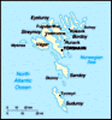Advertisement
Published: July 15th 2014
Day 3 and departure day
We woke to sunshine...hooray! We said our goodbyes to the GB group who were also parked the same spot as we were at Skala.
We then crossed back over the bridge between the 2 large islands and travelled along the east coast of Sreymoy Island to see the Fossa waterfall, up close and personal. That was pretty good.
We then drove to a little village at the northern tip of Streymoy - Tjornuvik and had lunch. There were a couple of children having a swim in the fjord - how could they!!!! It was freezing!!! Good on them.
We then drove back to Torshavn and visited the Nordic House which is the main cultural institution on the islands. A Faroese member of the Nordic Council, raised the idea of a Nordic cultural house in the Faroe Islands. A Nordic competition for architects was held in 1977, in which 158 architects participated. Winners were Ola Steen from Norway and Kolbrún Ragnarsdóttir from Iceland. By staying true to folklore, the architects built the Nordic House to resemble an enchanted hill of elves. The house opened in Torshavn in 1983. There are several 100 events,
performances and displays that occur throughout each year. It's fantastic to see.
We also admired the Tórshavn Cathedral, an attractive white building with clock tower - established in 1788.
Near the sports stadium there was a big park with a war memorial monument in the middle so it was good to walk through the large trees, something we didn't see much of during our driving around the islands.
We also spotted the Faroese løgting (The Faronese parliament), Tinganes. It was an impressive dark red structure with a green roof located on the water front. The parliament has been meeting at this site since 900 AD.
From here we drove south to a fascinating village, Kirkjubour, where half the houses had turf rooves. There was some of the world's oldest log houses. One in particular was Roykstovan, standing on a stone basement of a part of a bishop's palace, which has been the home of the farmers in Kirkjubour for centuries and occupied by the same Faroese family for 17 generations. I have included a number of photos of this building which is now a museum.
A great avalanche in 1772 severely damaged the cathedral in
this town. Recently, a rebuilding program has commenced, but it laid crumbled for all these years. Next to the ruin is a parish church which is the only medieval church still in use.
We then drove back to Tórshavn to prepare our departure on the ferry at 11.30pm Sunday night, back to Denmark. All went smoothly re our departure and we arrived in Hirstshals, northern Denmark at 9.30am on Tuesday morning.
If we were doing this trip to Iceland and Faroe Islands again, we would visit the Faroe Islands first as Iceland is larger and the most spectacular - but this doesn't mean that you should miss the Faroes. We have enjoyed our 14 days on this section of our 5 months. It's been incredible.
For those who want some history of the Faroe Islands, some follows:
The Faroe Islands' primary industry is the fishing industry, and the islands have one of the smallest independent economic entities in the world. The fishing industry accounts for over 80% of the total export value of goods, which are mainly processed fish products and fish farming. Tourism is the second largest industry, followed by woollen and other
manufactured products.
The unemployment rate in the Faroes is extremely low. The Faroese are trying to diversify their economy, but are divided about how to go about it. At present time most Faroese people work at the public sector as teachers, caretakers or having office jobs etc. The rise in the public sector workforce is highlighted by the fact that it is getting less and less popular to work at the fishing industry, and the private sector isn't big enough to support an educated and more demanding workforce.
The Faroes were colonized by Norwegians in the 9th century - according to history the first settler was Grímur Kamban, a Norwegian Viking who made his home in Funningur on Eysturoy in 825. The Faroese population has largely descended from these settlers. Recent DNA analyses have revealed that Y chromosomes, tracing male descent, are 87% Scandinavian. However, the studies also show that mitochondrial DNA, tracing female descent, is 84% Scottish. Today the population is 48,511
The Viking settlers established their own parliament called "ting" around 800. Local tings were established in different parts of the islands. The main ting was established on Tinganes in Tórshavn. About the turn of
the millennium the Faroes came under control of the Norwegian king. In 1380 the Faroes along with Orkney, Shetland, Iceland and Greenland, came with Norway into a union with Denmark. At the end of the Napoleonic wars, by the Treaty of Kiel in 1814, Denmark was forced to cede Norway to Sweden, but kept the Faroes, Iceland, and Greenland. In 1816, two years later, the Faroes were made into a Danish County and the old parliament was abolished. The Danish Governor became the highest authority in the Faroes.
In 1849 the Danish parliamentary constitution was made to apply in the Faroe Islands. In 1852 the Faroese parliament was reinstated as a county council, but served mainly as an advisory power. The Danish governor presided at all meetings and was a co-opted member. At the same time the Faroes came to be represented at the Danish parliament. It should be stated that, although the Faroe Islands have recognised the Royal powers, they have never been a part of Denmark. Only the Danish kingdom.
Advertisement
Tot: 0.05s; Tpl: 0.017s; cc: 14; qc: 26; dbt: 0.0275s; 1; m:domysql w:travelblog (10.17.0.13); sld: 1;
; mem: 1.1mb























